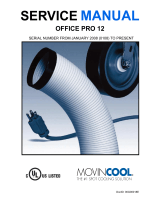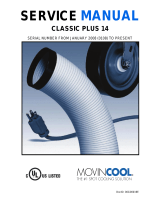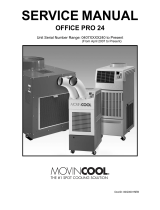Page is loading ...

CM SMART
Installation and Operating Instructions
GRUNDFOS INSTRUCTIONS

9 - 13
6 - 8
14 - 15
Contents

SMART
CM Pump
CM3 CM5

CM Pump

CM Pump
PRESSURE TANK PRE-CHARGE:
The Pressure tank pre-charge is pre-set. On site adjustment should be made with
power off and delivery line open so that there is no pressure on the system. The
pressure tank pre-charge should be 10% below cut in pressure.

5
4
4
Control panel
TM03 9361 1508
Pos. Description Function
1
"Pressure
scale"
The pressure scale has 13 light fields indicating the
pressure from 0 to 6 bar. All light fields illuminate
briefly when the power supply is switched on.
2 "Pump on"
The green indicator light is permanently on when
the pump is running. The indicator light also
illuminates briefly when the power supply is
switched on.
3 "Alarm"
The red indicator light is permanently on or flashes
when the pump has stopped due to an
operating fault. The indicator light also illuminates
briefly when the power supply is switched on.
4 [Reset]
The button is used for
• resetting of fault indications
• checking of DIP switch settings.
14 & 15
Pressure Manager
Pressure Manager
The Pressure Manager must be fitted on the
The Pressure Manager is a pressure regulator with
The Pressure Manager start and stops the pump
switch, the Pressure Manager ensures a steady flow
The Pressure Manager incorporates a pump dry-running
Pressure Manager to the piping system by meas
terminal box of the Pressure Manager
shows the control panel on the Pressure Manager
When the Pressure Manager has been installed and the

TM03 9220 3707 - TM04 1953 1508
IN
M
1~
L1
L1
N
PE
N
U
V
1x115/230 V
50/60 Hz, PE
6
OUT
5
4
3
2
1
IN
M
3~
L1
L3
N
L1
L2
PE
N
U
V
1x230 V
50/60 Hz, PE
6
OUT
5
4
3
2
1
TM04 1991 1708
Functions
Auto-reset
When the auto-reset function is enabled, cycling and dry-running alarms will be automatically
reset. To enable the function, set DIP switch 6 to "ON".
Anti-cycling
To avoid inadvertent starts and stops of the pump in case of a failure in the installation,
the anti-cycling function can be enabled. The function will detect cycling if it occurs and stop
the pump with an alarm. When the PM 2 has been set to start/stop according to water
consumption, cycling may occur in the following situations:
•In case of a minor leakage.
•If a tap has not been entirely closed.
When the PM 2 has been set to start/stop with 1 bar differential pressure, cycling may occur
in the following situations:
•If the pressure tank has lost its precharge pressure.
•If the size of the pressure tank is insufficient.
If the cycling alarm has been activated, the pump can be restarted manually by pressing [Reset].
When the auto-reset function is enabled, the pump will be restarted automatically after 12 hours
in alarm condition. To enable the function, set DIP switch 7 to "ON".
Maximum continuous operating time (30minutes)
When this function is enabled, the pump will be stopped when the pump has been running
continuously for 30 minutes.
Restart the pump by pressing [Reset].
The purpose of this function is to avoid unnecessary water and current consumption,
e.g. in case of pipe Tfracture or considerable leakages.
To enable the function, set DIP switch 8 to "ON".
Caution
The auto-reset function should NOT be enabled on pumps which cannot self-
prime when water returns after dry-running.
Note
In case of a very small consumption, the anti-cycling function may register
this as a minor leakage and stop the pump inadvertently. If this occurs, the function can be disabled.
Note
When the function is enabled, any consumption exceeding 30 minutes will cause an alarm, and the
pump will be stopped. If enabled, the auto-reset function will not restart the pump.
Pressure Manager
Pressure Manager

DIP switches
The PM 2 has a number of settings which can be
made with the DIP switche behind the control panel.
See fig. 6.
+1.0
+1.0
4 +1.0
5 STOP = START + 1
6 AUTO RESET
ANTI CYCLING
MAX RUN 30 MIN.
OFF/ON
START
1.5 BAR 1
2
+
0.5
3
4 +1.0
5 STOP = START + 1 BAR
6
7
8
Enabling the DIP switch settings
To enable the DIP switch settings, press [Reset] or disconnect and reconnect the
power supply to the unit.
Note
When the desired DIP switch settings have been made, they must be enabled,
otherwise the PM 2 cannot detect the settings.
Checking the DIP switch settings
When [Reset] is kept pressed for at least 3 seconds, the light fields for the DIP switches
set to "ON" will illuminate in the pressure scale. The light fields illuminate from right
to left. This means that if the light field to the far right is on, DIP switch 8 has been set
to "ON", etc. See the table below.
Light field [bar] 2.5 3.0 3.5 4.0 4.5 5.0 5.5 6.0
DIP switch no. 1 2 3 4 5 6 7 8
Pressure Manager
Pressure Manager

Checks (Possible causes)
1. The pump does
not run.
Check cables and cable connections for
defects and loose connections.
b) Fuses are blown.
See 2. a), b), c), d), e), f).
d) Control-current circuit
defective.
Repair or replace the control-current
circuit.
2. Motor-protective
circuit breaker has
tripped (trips out
immediately when
supply is switched
on).
a) Fuses are blown
b) Contacts of the motor-
protective circuit breaker
or magnet coil defective.
Replace the contacts of the motor-
protective circuit breaker, the magnet
coil or the entire motor-protective
circuit breaker.
c) Cable connection is loose
or faulty.
Check cables and cable connections
for defects, and replace the fuses.
d) Motor winding is defecti
ve.
e) The pump is mechanically
blocked.
Switch off the power supply, an
clean or repair the pump.
f) The setting of the motor-
protective circuit breaker is
too low.
Set the motor-protective circuit
breaker according to the rated
current of the motor (I1/1). See
nameplate.
3. The motor-
protective circuit
breaker trips out
occasionally.
a) The setting of the motor-
protective circuit breaker is
too low.
See 2.f).
b) Periodic supply failure.
c) Periodically low voltage.
Check that the supply cable of the
pump is correctly sized.
a) Supply failure. Switch on the switch.
Check cables and cable connection for
defects, and replace the fuses.
See 1. b).
See 2.c).
Check cables and cable connections
for defects and loose connections.
c) Motor protection tripped.
Warning
Before starting work on the pump, make sure that the power supply to the pump has been
switched off and that it cannot be accidentally switched on.
Fault Remedy
Repair or replace the motor.
Fault Finding Chart

5. The pump runs,
but gives no
water.
a) Pump inlet pressure too low.
b) The suction pipe is partly
clogged by impurities.
See 5. b).
c) The foot or non-return valve
is stuck in its closed position.
Remove and clean, repair or replace
the valve.
d) Leakage in suction pipe.
e) Air in suction pipe or pump.
See 5. a).
See 5. c).
See 5. d).
7. The pump runs
with reduced
performance.
a) Wrong direction of
rotation.
Three-phase pumps only:
Switch off the power supply with the
external circuit breaker, and interchange
two phases in the pump terminal box.
See also section 8.2 Checking the
direction of rotation.
b) See 5. a), b), c), d).
6. The pump runs
backwards when
switched off.
a) Leakage in suction pipe.
b) Foot or non-return valve
defective.
See 6. c).
c) The foot valve is stuck in
completely or partly open
position.
See 6. c).
See 5. c).
4. The pump
performance is
unstable.
a) Pump inlet pressure too
low.
b) Suction pipe is partly
blocked by impurities.
Remove and clean the suction pipe.
c) Leakage in suction pipe.
d) Air in suction pipe or pump.
Check the inlet conditions of the
pump.
Remove and repair the suction pipe.
Vent the suction pipe/pump. Check
the inlet conditions of the pump.
8. The green light
field for "0 bar"
is off even if
the power
supply has
been switched
on.
a) The fuses in the electric
installation have blown.
Replace the fuses. If the new fuses also
blow, check the electric installation.
b) The earth leakage circuit
breaker or the voltage-
operated circuit breaker has
been tripped out.
Cut in the circuit breaker.
c) No power supply.
d) The PM unit is defective.
Contact the power supply authorities.
Repair or replace the PM unit.
10
Checks (Possible causes)
Fault Remedy
Fault Finding Chart

11
9. The green
"Pump on"
indicator light is
on, but the
pump does not
start.
a) The power supply to the pump
is disconnected after the PM
unit.
Check the plug and cable connections,
and check if the built-in circuit breaker
of the pump is switched off.
b) The motor protection of the
pump has tripped out due to
overload.
Check if the motor/pump is blocked.
c) The pump is defective.
d) The PM unit is defective.
Repair or replace the pump.
Repair or replace the PM unit.
10. The pump does
not start when
water is
consumed.
"Pump on" is
off.
a) Too big difference in height
between the PM unit and the
tapping point.
Adjust the installation, or increase the
start pressure.
b) The PM unit is defective.
Repair or replace the PM unit.
11. System
wi
thout
pressure tank:
Frequent
starts/stops.
a) DIP switch 5 set to "ON".
b) Leakage in the pipework.
c) The non-return valve is stuck
in open position.
Clean or replace the non-return valve.
Set DIP switch 5 to "OFF".
Check and repair the pipework.
Checks (Possible causes)Fault Remedy
8. The green light
field for "0 bar"
is off even if
the power
supply has
been switched
on.
a) The fuses in the electric
installation have blown.
Replace the fuses. If the new fuses also
blow, check the electric installation.
b) The earth leakage circuit
breaker or the voltage-
operated circuit breaker has
been tripped out.
Cut in the circuit breaker.
c) No power supply.
d) The PM unit is defective.
Contact the power supply authorities.
Repair or replace the PM unit.
12. System with
pressure tank:
Frequent
starts/stops.
a) The pressure tank has no
precharge pressure, or the
tank size is insufficient.
Check the tank precharge pressure, and
recharge the tank, if necessary. If the
size of the pressure tank is insufficient,
set DIP switch 5 to "OFF", or replace the
pressure tank.
b) Leaky non-return valve.
Clean or replace the non-return valve.
Fault Finding Chart

13. The pump does
not stop.
a) The pump cannot deliver the
necessary discharge pressure.
Replace the pump.
b) The start pressure is set too
high.
c) The PM unit is defective.
d) The non-return valve is stuck
in open position.
Clean or replace the non-return valve.
14. The red
"Alarm"
indicator light
is permanently
on.
a) Dry running. The pump needs
water.
Check the pipework.
b) The power supply to the pump
is disconnected after the PM
unit.
Check the plug and cable connections,
and check if the built-in circuit breaker
of the pump is switched off.
c) The motor protection of the
pump has tripped out due to
overload.
Check if the motor/pump is blocked.
d) The pump is defective.
e) The PM unit is defective.
Repair or replace the PM unit.
Repair or replace the pump.
Repair or replace the PM unit.
Decrease the start pressure.
16. System with
pressure tank:
The red
"Alarm"
indicator light
flashes once
per period.
a) Cycling.
The pressure tank has no
precharge pressure, or the
tank size is insufficient.
Check the tank precharge pressure, and
recharge the tank, if necessary. If the
size of the pressure tank is insufficient,
set DIP switch 5 to "OFF", or replace the
pressure tank. See section 8.2
Anti-cycling.
15. System
without
pressure tank:
The red
"Alarm"
indicator light
flashes once
per period.
a) Cycling.
A tap has not been closed
entirely after use.
Check that all taps have been closed.
See section 8.2 Anti-cycling.
b) Cycling.
There is a minor leakage in
the system.
Check the system for leakages.
See section 8.2 Anti-cycling.
12
Checks (Possible causes)
Fault Remedy
Fault Finding Chart

17. The red
"Alarm"
indicator light
flashes twice
per period.
a) Maximum continuous
operating time (30minutes).
The pump has been running
continuously for 30minutes.
Check the system for leakages.
Disable the function to allow the pump
to run for 30 minutes. See section 8.3
Maximum continuous operating time
(30minutes).
18. The red
"Alarm"
indicator light
flashes three
times per
period, and
each pump
start is delayed
a few seconds.
a) Too many start/stop
sequences within a short
period. The pressure tank
has no precharge pressure,
or the tank size is insufficient.
Check the tank precharge pressure,
and recharge the tank, if necessary.
If the size of the pressure tank is
insufficient,set DIP switch 5 to "OFF",
or replace the pressure tank. Set DIP
switch 5 to "OFF".
b) Too many start/stop
sequences within a short
period. The PM 2 is set to start
stop with 1 bar differential
pressure, i.e. DIP switch 5 is set
to "ON", but no pressure tank
has been installed in the system.
19. The red
"Alarm"
indicator light
flashes four
times per
period.
a) Pressure sensor fault.
Repair or replace the PM unit.
13
Checks (Possible causes)
Fault Remedy
Fault Finding Chart

14
Installation

15
Installation

16
Overall Diagram

17
Overall Diagram

18
Overall Diagram

19
Overall Diagram

Subject to alterations.
CM SMART-1115
Cert No.: KLR 0402930
Website : www.grundfos.com
Toll Free No. : 1800 88 PUMP (7867)
/





